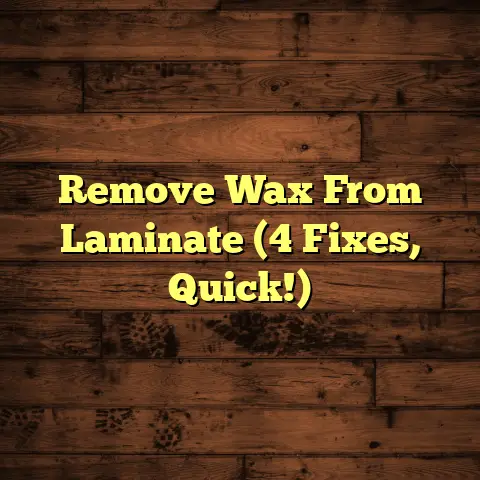Getting Rid Of Stains On Engineered Hardwood Floors
Engineered hardwood flooring can add warmth and beauty to any home.
However, like all floors, engineered hardwood is susceptible to stains from spills, pets, shoes, and daily wear and tear.
Thankfully, with the right techniques and products, even set-in stains can be removed from factory-finished hardwood planks.
This comprehensive guide will teach you how to identify, treat, and prevent various types of stains.
With a little knowledge and elbow grease, you can keep your floors looking like new for years to come.
We’ll cover quick fixes for recent stains as well as more involved stain removal processes for tough, dried-in stains.
So grab your cleaning supplies and let’s get started!
With the right solutions and techniques, you can erase stains from mud, food, grease, wax, and more from the surface of your engineered flooring.
Types of Stains on Engineered Hardwoods
Before diving into treatments, it’s helpful to understand what kinds of stains can affect engineered hardwood and what causes them.
Here are some of the most common culprits:
Food and Beverage Stains
Food and drinks like wine, coffee, juice, and cooking oils can quickly stain light and dark engineered floors alike.
Sugary spills are particularly sticky and may penetrate the finish and stain the wood if left untreated.
Water and Moisture Marks
Excess water exposure from spills, pets, cleaning, or leaks can warp planks and leave behind white hazy marks, discoloration, and even black mold or mildew if untreated.
Grease and Wax Buildup
Over time, oil, wax, and greasy residue from furniture, shoes, cars, and other sources can create a gummy film that attracts dirt and dulls the floor’s shine.
Filth and Grime
Mud and dirt tracked inside can grind into the grain and seam gaps.
Pet urine and feces can also stain and create an unpleasant odor if not cleaned up quickly.
Sun Exposure
Like natural solid hardwood, the sun’s UV rays can fade, discolor, and dry out engineered wood over time.
Installing curtains or blinds can help prevent damage.
Scratches and Gouges
Dragging furniture, active pets, falling objects, and heavy foot traffic with abrasive particles (dirt, sand, pebbles) can scratch and dent engineered floors.Now let’s explore your stain removal options based on stain type and severity.
Cleaning and Removing Light Stains from Engineered Hardwood
For fresh spills and surface-level scuffs, quick everyday cleaning is often sufficient for stain removal from engineered hardwood floors.
Here are some light duty cleaning tips:
Blot Spills Immediately
For food, drink and pet stains under 24 hours old, promptly blot the area with absorbent towels.
Avoid scrubbing liquids as this can spread the stain.
Carefully lift solid debris.
Vacuum and Sweep Regularly
Frequently remove grit, dirt, pet hair, and other debris that can grind into flooring with a soft brush or vacuum attachment.
This will minimize scratches and stains over time.
Spot Clean with Hardwood Floor Cleaner
For minor stains, dip a soft cloth into an engineered hardwood floor cleaner and gently blot the affected area.
Avoid household cleaners and soap-based products.
Damp Mop Lightly with Water Only
For cleansings between deep treatments, use a barely damp mop to wipe away surface dust and debris.
Avoid excessive moisture and standing water.
Use Furniture Pads and Doormats
Attach felt pads underneath furniture legs and place mats at entrances to minimize scratches, trapped debris, and moisture transfer.
Removing Old or Set-In Stains from Engineered Hardwood
Over time, spills can become stubborn stains, grease and wax can build up, moisture damage can set in, and traffic patterns can become ingrained with dirt.
To tackle these more difficult stains on engineered hardwood floors without damaging the finish, try these techniques:
Dish Soap and Water
For oily grease stains or waxy buildup, mix a mild dish detergent like Dawn and warm water.
Gently scrub the area using a soft cloth, nylon brush or magic eraser sponge.
Avoid excessive water.
White Vinegar
The acids in undiluted white vinegar can break up residue from grease, wax, and some fading.
Dip a soft cloth into vinegar and blot onto the stain.
Allow it to sit for 5-10 minutes then wipe clean.
Hydrogen Peroxide
For organic stains from food, plant matter, urine, blood or mold, hydrogen peroxide can lift and whiten the affected area.
Dip a soft cloth into the solution and allow to bubble on the floor for 10-15 minutes before blotting.
Baking Soda Paste
This gentle abrasive can lift stains from dirt, grime, coffee and other liquids without damaging the finish.
Make a paste with water and baking soda then lightly scrub with a damp cloth.
Wipe clean when done.
Mineral Spirits
For tougher oil-based stains and paint splatters, gently rub mineral spirits into the area using steel wool or a chemical-resistant cloth, then wipe clean.
Use gentle pressure to avoid scratching.
Wood Floor Deep Cleaners
For professional-grade cleaning, pour an engineered floor deep cleaning solution like Bona Hardwood Floor Cleaner into a bucket.
Dip a terry cloth mop into the mixture, then wring thoroughly.
Apply to flooring using a back and forth motion then allow to sit 5-10 minutes.
Use terry towels to blot and wipe away the loosened stain residue.
Buff dry.
Preventing Future Stains and Damage
Once you’ve conquered stains with the above removal tips, consider these maintenance practices to prevent new stains and damage long-term:
Add Protective Mats
Place waterproof mats with a nonslip backing in high traffic areas and at entryways to minimize wear, staining, moisture, and grit.
Apply Floor Protectants
Use specially formulated hardwood floor waxes and urethane coatings like Bona Hardwood Floor Refresher to create an extra moisture and stain barrier.
Reapply as needed per manufacturer instructions.
Install Humidity Controls
Use dehumidifiers, humidifiers and HVAC systems to maintain 40-60% humidity levels in the home.
This prevents cracks, warping and moisture damage.
Filter Indoor Air Quality
Reduce staining from everyday dust, dander and smoke by using HEPA air filters in HVAC systems along with portable room purifiers.###Rearrange Furniture PeriodicallyRotate the placement of furniture every few months to allow even exposure to light and foot traffic.
This prevents uneven fading and wear patterns over time.
Shake Out Doormats and Area Rugs
Prevent tracked-in staining and abrasive debris by regularly shaking out and cleaning all entrance mats, area rugs and carpets.
Engineered Hardwood Floor Stain Removal FAQs
Still have questions about removing pesky stains from factory finished engineered flooring?
Here are answers to some frequently asked questions:
What is the easiest way to remove old or set-in stains?
For most dried, stubborn stains, a wood floor deep cleaning solution is the easiest and most effective way to dissolve and lift residue from the floor’s finish.
Popular ready-to-use options are Bona Hardwood Floor Cleaner, Zep Hardwood Floor Deep Cleaner, and Method Wood for Good Polish.Combine the cleaner with a terry cloth mop, let it sit for 5-10 minutes, then wipe away.
Avoid excessive moisture and immediately blot up excess liquid.
Can I use steam mops on engineered hardwood floors?
In general, steam mops are not recommended for engineered hardwood floors.
The heat and moisture can dull pre-finished surfaces, warp planks, and leave lasting water marks.
For deeper cleaning, use a hardwood floor cleaner and terry mop instead.
What removes pet urine and feces stains from engineered floors?
For organic pet stains, spray the area with an enzymatic cleaner like Nature’s Miracle.
Allow it to soak in for 5-10 minutes to break down waste and lift staining from wood pores and seams.
Blot gently then rinse the area well.
Avoid using excessive moisture during cleanup which can further damage floors.
What is the best way to clean engineered hardwood floor grout?
Factory finished engineered wood floors are installed as floating planks without grout between them.
If you have a custom unfinished engineered floor sealed with grout or a wood-look composite floor, scrub stains gently from the grout lines using a soft bristle grout brush, mild dish soap, and warm water.
Blot the area dry when finished.
How do you remove water stains from engineered hardwood floors?
White hazy water marks require drawing out the moisture with fans and dehumidifiers, then refinishing the raw wood beneath the warped finish.
Prevent this extensive damage by promptly soaking up spills and placing leak trays under potted plants and appliances.
Install humidity controls throughout the home and avoid steam cleaners.
Conclusion
I hope this comprehensive engineered hardwood floor stain removal guide gives you confidence to erase spots, prevent future stains, and keep your investment looking beautiful for years.Remember to:
- Blot spills quickly
- Sweep and vacuum debris regularly
- Spot clean minor stains with hardwood floor cleaner
- Use protective mats and furniture pads
- Apply wood floor refresher coats
- Install humidity controls in the home
With the right techniques and products, even dried-in stains don’t stand a chance against your cleaning efforts!
Just be patient in allowing solutions to penetrate and lift stains before wiping.
Your perseverance will pay off.
If stains persist despite your best efforts, consider calling in a hardwood flooring professional to deep clean and resurface overly damaged areas.
Future preventative care is key.
Now that you’re armed with stain removal knowledge, you can keep your engineered hardwood floors in tip-top shape for decades to come!





